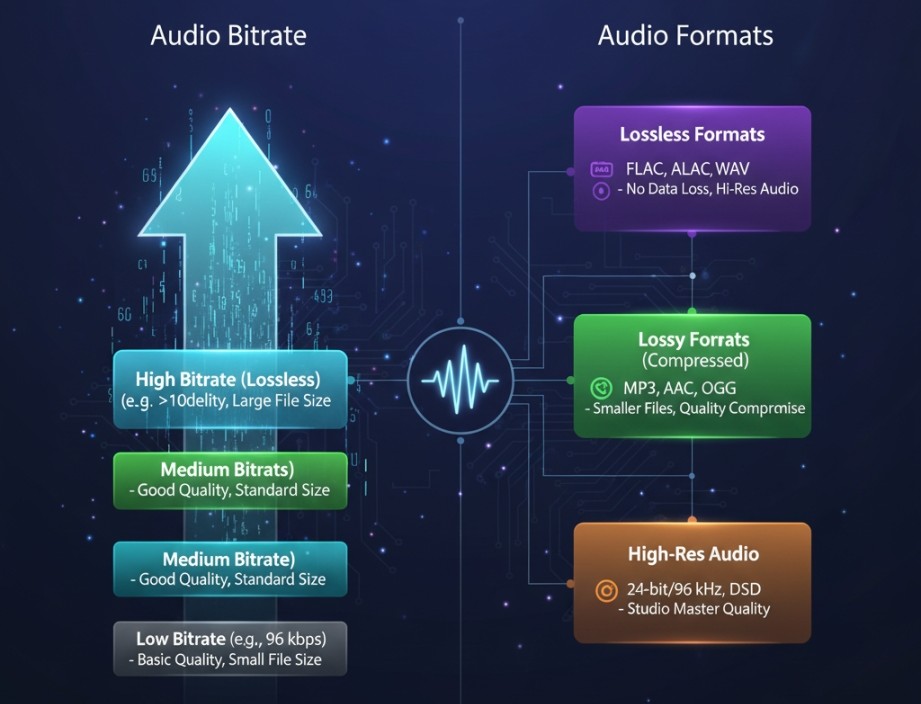Let’s dive right in, shall we…
What is bitrate? Well, to answer this, we need to start at the beginning.
Digital audio is digital information. This information can be big or small, high, or low. Bitrate is a term used to describe the amount of data transferred in audio format. A more increased audio bitrate usually means better audio quality.
To understand bitrate, you also need to know what an audio file is and what different types of audio formats there are.
When we talk about audio files, we use terms like audio formats, extensions, and audio codecs. In simple terms, this format is just a file type, identified by its extension (*.mp3, *.wav, *.ogg, *.wma, etc.), which usually tells us how to encode the code., or its audio codec.
For example, files in MP3 audio format have the extension *.mp3 and the MPEG-1 Audio Layer III audio codec.
These extensions are mixed, but the important thing to know is that, like video, files with one type of extension do not have the same audio codec as another.
This information is useful so that you don't get lost if you don't understand why the software you usually use to call your *.m4a file suddenly refuses to call someone else with the same extension, for example.

This condition may indicate that the audio codecs used are different and thus different audio formats. In this case, the solution will be to use another software to play the file or do the conversion (re-encoding), which will be done in video editors.
These audio formats and audio codecs are based on the choice of the company that produces the software that runs the file. This is where many things come in, such as technical specifications and even patent relations. As for files, they are usually divided into two types: uncompressed or compressed.
A dedicated backup tool often gives us the option to save files without losing information. These files can be created seamlessly in many audio formats and extensions, such as WAV, AIFF, FLAC, and ALAC.
However, even if you don't want to finish the audio format as WAV (one of the most common), the uncompressed audio format can be useful during the composition process. Because they contain a lot of information, they support critical changes without audio noise.
Therefore, by using plugins, conversions, and processing, you can manage them for free, guaranteeing good quality, even if the files are compressed.
Most of the devices on the market (cameras, mobile phones, and even audio recorders) deliver pre-compressed files. These audio formats and files are compact, easy to organize and require less storage space, with smaller file sizes (in bytes).
Some examples of these audio formats are 3GP, AAC, M4A, OGG, WMA, and MP3, which are undoubtedly the most well-known. Thanks to a complex algorithm, these files are created keeping only the information in our ears.
Depending on the compression mode, you can create an MP3 from a WAV file and have a file 10 times smaller, without any noticeable sound changes.
Speaking of MP3, despite its great popularity, this audio format is now considered obsolete, while others, such as ACC (extensions. acc or .m4a) allow even smaller files.
But MP3 continues to be used as many software and tools have been developed for this audio format.
Now that you understand that the file can be compressed while maintaining the perfect quality for our ears, you should know that this compression level can vary based on the different audio formats.
It is thanks to the value of the compression rate (or audio bitrate) that we can control the size of the file and therefore the audio quality. For example, a 320 kbps (kilobits per second) MP3 can sound like a CD or DVD audio format without compression. As the audio bitrate decreases, the audio file becomes smaller, but the audio loss becomes more apparent, depending on the audio in question.
Now that you have a better understanding of what audio formats are and what audio bitrate all means, let’s take a look at how our products fit into the mix.
Cleer Audio Device |
Supported Audio Formats |
MP3, SBC, aptX |
|
MP3, SBC, aptX Adaptive |
|
MP3, SBC, aptX Adaptive |
|
MP3, SBC, aptX Adaptive |
|
MP3, SBC, aptX |
|
MP3, SBC, Qualcomm® aptX Adaptive |
|
MP3, SBC, AAC, aptX adaptive |
|
MP3, SBC, AAC, aptX HD |
|
n/a |
|
MP3, WMA, FLAC, Apple Lossless |
As you can see, our devices support a wide range of audio formats and files, which means that regardless of what you’re listening to, you can rest assured knowing that it will be played in the best possible quality.
[READ MORE: What Is an Audio Codec? Demystifying AAC, SBC, and aptX for Wireless Headphones]Cleer © 2025. All rights reserved reproduction in whole or in part without written permission is prohibited. Cleer and the Cleer logo are trademarks of Cleer, ltd.

Be notified of exclusive offers, new product releases, giveaways and more!
 UNITED STATES
UNITED STATES CANADA
CANADA